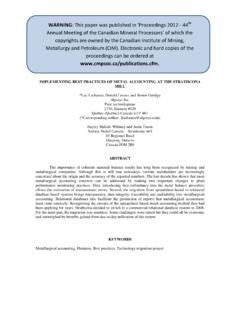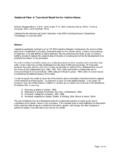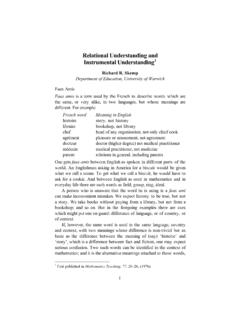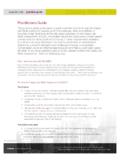Transcription of Paradigms of global public relations in an age of ...
1 Paradigms of global public relations in an age of digitalisation James E. Grunig, University of Maryland practitioners view the new digital social media Abstract as a revolutionary force that changes the way Although the attention being paid to the new they think and upsets the way they practise digital media may be the latest fad in public public relations . relations , these new media have the potential Fads change quickly, however, and public to make the profession more global , strategic, relations practitioners have rapidly embraced two-way and interactive, symmetrical or social media as being at the centre of what they dialogical, and socially responsible. consider to be a new form of public relations . However, many practitioners are using the The traditional media frenzy of so many new media in the same ways they used the practitioners has been replaced by a new social old as a means of dumping messages on the media frenzy. Each day, I receive general population rather than as a strategic announcements of conferences, seminars, means of interacting with publics and online discussions, publications, books, bringing information from the environment websites, and blogs discussing how into organisational decision-making.
2 For practitioners can use social media to public relations to fully use digital media, revolutionise their public relations work. practitioners and scholars must Although many practitioners have simply reinstitutionalise public relations as a transferred their traditional media skills and behavioural, strategic management paradigm techniques to digital media, the new fascination rather than as a symbolic, interpretive with social media promises to have positive paradigm. This article provides a model of consequences for the public relations strategic public relations and offers profession. If the social media are used to their suggestions for the use of digital media in full potential, I believe they will inexorably each phase of this model. make public relations practice more global , strategic, two-way and interactive, symmetrical Introduction or dialogical, and socially responsible. In 1996, Ver i , Grunig, and Grunig public relations has long been a professional proposed a global theory of public relations that practice where fads are common and was elaborated by Sriramesh and Ver i (2003, conceptualisation of faddish concepts is weak 2009) in their global public relations or nonexistent.
3 public relations fads have Handbook and by Sriramesh in this special focused on such concepts as images, issue of PRism. Our global public relations perceptions, messaging, reputation, brands, theory attempted to answer the question of integrated marketing communication, return whether public relations theory and practice on investment (ROI), strategic should be unique to each country or culture or communication, and corporate social whether it should be practiced in the same way responsibility projects. Most practitioners everywhere. We answered this question by following these fads have skill sets that are theorising that global public relations should limited to media and media relations , and fall in the middle between standardisation and they fervently believe that publicity in individualisation. We theorised that, at an traditional media will produce the faddish abstract level, there are a set of generic outcome currently in vogue. Thus, it is not principles that could be applied universally but surprising that so many public relations 1.
4 Grunig, J. E. (2009). Paradigms of global public relations in an age of digitalisation. PRism 6(2): that at a local level these principles should be tool for other departments such as marketing, applied differently in different locations. I human resources, law, or finance. When the emphasise the words could' and should' in function is sublimated to other functions, it the previous sentence because we did not cannot move communication resources from argue that public relations is' currently one strategic public to another as it becomes practiced according to these principles, as, for more or less important as an integrated example, Bardhan (2003) mistakenly function can. interpreted one principle of the global theory Headed by a strategic manager rather (symmetrical communication) in a study of than a communication technician or an Indian public relations . administrative manager who supervises Our global theory is not a positive theory, technical services. Technicians are essential to which describes a type of public relations that carry out day-to-day communication activities.
5 Currently is practiced everywhere in the However, excellent public relations units have world. Research, such as that reported in the at least one senior manager who directs public global public relations Handbook relations programmes; or this direction will be (Sriramesh & Ver i , 2003, 2009), does show provided by members of the dominant coalition that there are many idiosyncrasies in public who have no knowledge of public relations . relations practice around the world that reflect Involved in strategic management. cultural differences. It also shows that the one public relations develops programmes to worldwide universal in public relations communicate with strategic publics, both practice is what I have called the press external and internal, who are affected by the agentry/publicity model (Grunig, Grunig, consequences of organisational decisions and Sriramesh, Huang, & Lyra, 1995) the least behaviours and who either demand or deserve a effective of the models.
6 Rather, our global voice in decisions that affect them both theory is a normative theory that argues that before and after decisions are made. public relations will be most effective Two-way and symmetrical throughout most parts of the world when it communication. Two-way, symmetrical public follows the generic principles and applies relations uses research, listening, and dialogue them with appropriate variations for local to manage conflict and to cultivate relationships cultural, political, social, and economic with both internal and external strategic publics conditions. Its absence in a country, however, more than one-way and asymmetrical does not serve as evidence that it could not be communication. practiced there. Diverse. Effective organisations attempt The generic principles have been described to increase the diversity in the public relations in different ways in different publications, but function when the diversity in their the essential principles can be summarised as: environments increases.
7 Excellent public Empowerment of public relations . relations includes both men and women in all The chief communication officer is part of or roles, as well as practitioners of different racial, has access to the dominant coalition or other ethnic, and cultural backgrounds. coalitions of senior managers who make Ethical. public relations departments decisions in the organisation. practice ethically and promote ethical and Integrated communication function. socially responsible organisational decisions Excellent departments integrate all public and behaviours. relations functions into a single department or We have identified six contextual conditions have a mechanism to coordinate the that should be taken into account when these departments responsible for different generic principles are applied multinationally: communication activities. culture, the political system, the economic A separate management function. system, level of economic development, the Many organisations splinter the public extent and nature of activism, and the media relations function by making it a supporting system (see Sriramesh's discussion of the 2.)
8 Grunig, J. E. (2009). Paradigms of global public relations in an age of digitalisation. PRism 6(2): contextual conditions in this special issue). At are moving rapidly to adjust to this change in times, these contextual conditions make it media. According to a report from iPressroom, difficult to apply the generic principles, such Trendstream, PRSA, and Korn/Ferry as in a country with an individualistic or International, as reported in PR News online masculine culture, an authoritarian political (2009), 51% of public relations departments in system, or a low level of activism. the United States are responsible for digital Nevertheless, I believe that the principles can communication, 49% for blogging, 48% for be practiced incrementally, and carefully, social networking, and 52% for micro blogging almost everywhere. The new digital media, I (such as text messaging, instant messaging, and also believe, are a global force that conform Twittering). In addition, a 2007 study by the well to the generic principles and that make it Arthur Page Society, a US association of chief possible to overcome the contextual corporate communication officers, included conditions that limit the practice of these Leadership in enabling the enterprise with principles.
9 New media' skill and tools (p. 7) as one of As of June 30, 2009, there were four priorities and skills that will be needed by 1,668,870,408 internet users in the world chief communication officers (CCOs) in the 24% of the world's population of nearly future. (The other three skills, which fit billion (Internet World Stats, 2009). The squarely into our global theory of public percentage of the population that uses the relations , were leadership in defining and internet ranges from in Africa to instilling company values, building and in North America. Internet usage is higher in managing multi-stakeholder relationships, and developed regions of the world ( in building and managing trust.). Europe and in Oceania/Australia) than Recent books on online public relations , in developing regions ( in the Middle such as Phillips and Young (2009) and Solis East and in the Latin and Breakenridge (2009) have argued that the American/Caribbean region). Although only digital media have changed everything for of the Asian population uses the public relations : The Web has changed internet, of all internet users in the everything (Solis & Breakenridge, 2009, p.)
10 1);. world are in Asia. In addition, internet use it is hard to avoid making the claim that worldwide grew 362% from 2000 to 2009, the internet changes everything.' for public including 516% in Asia, 1,360% in the relations the unavoidable conclusion is that Middle East and Africa, and 873% in the nothing will ever be the same again (Phillips Latin American/Caribbean region. Finally, in & Young, 2009, ). In one sense, I agree with 2008, China surpassed the United States as these assertions. For most practitioners, digital having more internet users than any other media do change everything about the way they country in the world ( , 2009). On practice public relations . Other practitioners, December 31, 2008, there were 298 million however, doggedly use the new media in the internet users in China, 22% of the same way that they used traditional media. population, with an annual growth rate of From a theoretical perspective, in addition, I do (China Internet Network Information not believe digital media change the public Center, 2009).






